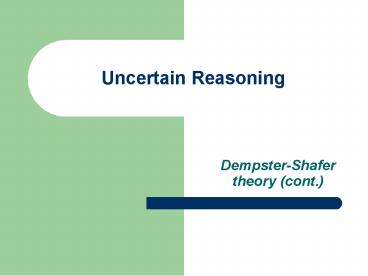Uncertain Reasoning - PowerPoint PPT Presentation
1 / 8
Title:
Uncertain Reasoning
Description:
Uncertain Reasoning. Dempster-Shafer theory (cont.) Dempster-Shafer theory of evidence ... Evidently, we assume that the domain O is the same for both sensors. ... – PowerPoint PPT presentation
Number of Views:65
Avg rating:3.0/5.0
Title: Uncertain Reasoning
1
Uncertain Reasoning
- Dempster-Shafer theory (cont.)
2
Dempster-Shafer theory of evidence
- Knowledge representation issues let O ?1,
..., ?n. - If ?i is known to be the true value, then
- m(?i) 1.
- m(A) 0 otherwise.
3
Dempster-Shafer theory of evidence
- Knowledge representation issues bayesian
special case. - If m(?i) is known for every element ?i of O,
then there is no ignorance and the probabilities
of all events are known - Si1nm(?i) 1.
- m(A) 0 if A is not a singleton.
4
Dempster-Shafer theory of evidence
- Knowledge representation issues total
ignorance. - The case of total ignorance about the
probabilities of events can be characterised as
follows - m(O) 1.
- m(A) 0 for every A c O such that A ? O.
5
Dempster-Shafer theory of evidence
- Knowledge representation issues information
fusion. - One of the most important and interesting
features of the Dempster-Shafer theory of
evidence is the ability to combine information
from different independent sources. For example,
assume that two sensors inform two different mass
distributions m1 and m2. Evidently, we assume
that the domain O is the same for both sensors.
6
Dempster-Shafer theory of evidence
- Knowledge representation issues information
fusion. - K S A, B A n B m1(A)m2(B).
- If K lt 1, then information fusion is possible.
7
Dempster-Shafer theory of evidence
- Knowledge representation issues information
fusion m1 m2. - If C ? , then(m1 m2)(C) (1/K) S A, B A
n B C m1(A)m2(B). - Otherwise, (m1 m2)( ) 0.
8
Dempster-Shafer theory of evidence
- Knowledge representation issues information
fusion m1 m2. - (m1 m2)(C) is commutative and associative.































